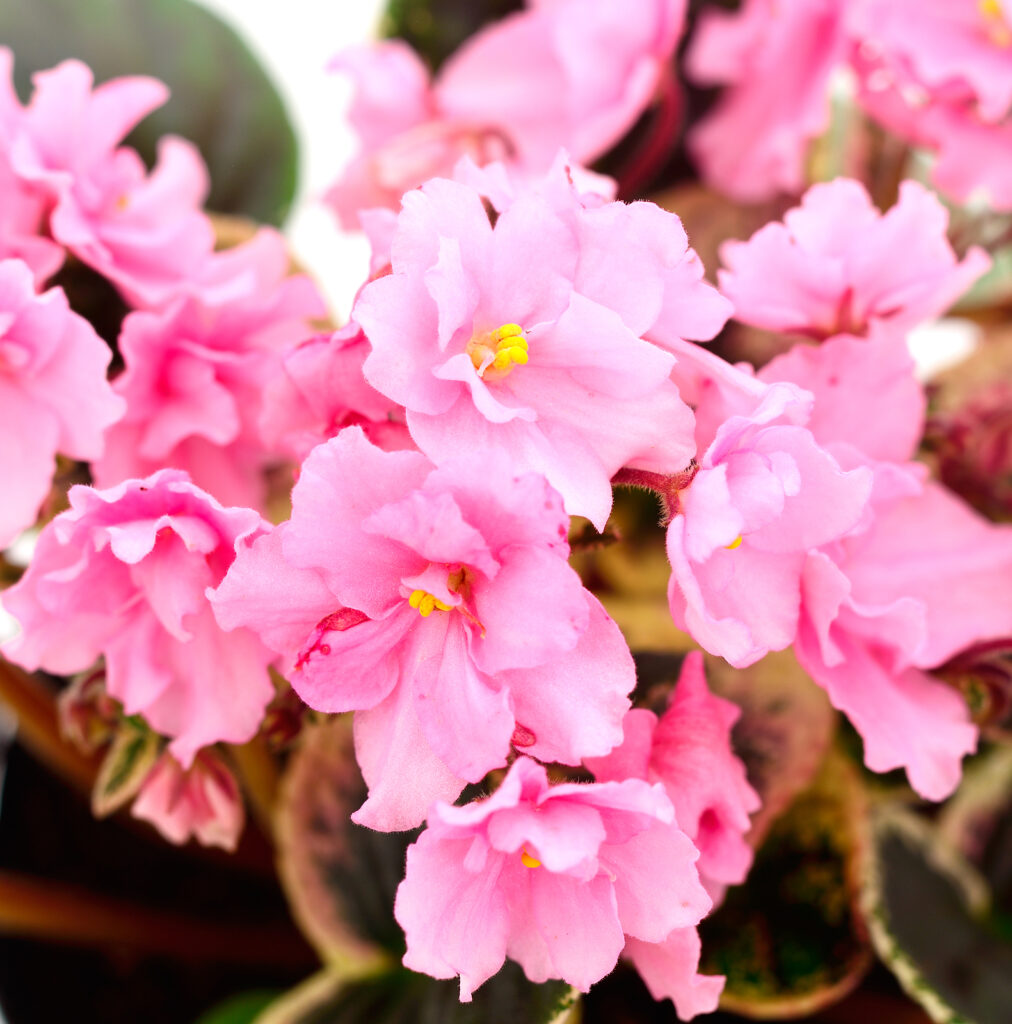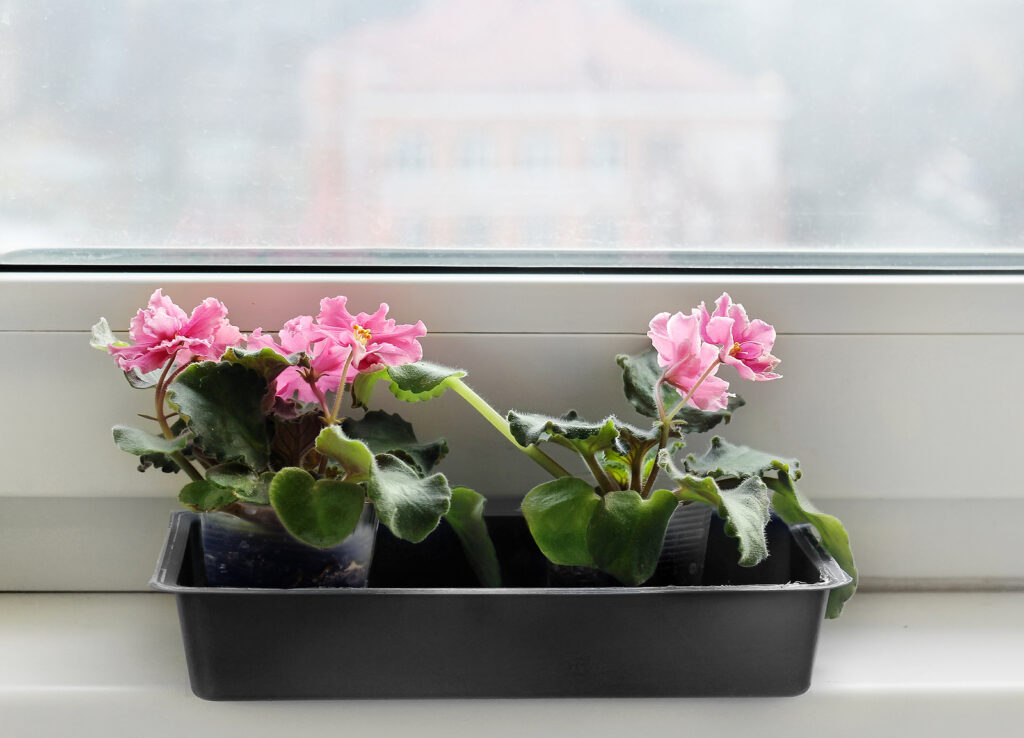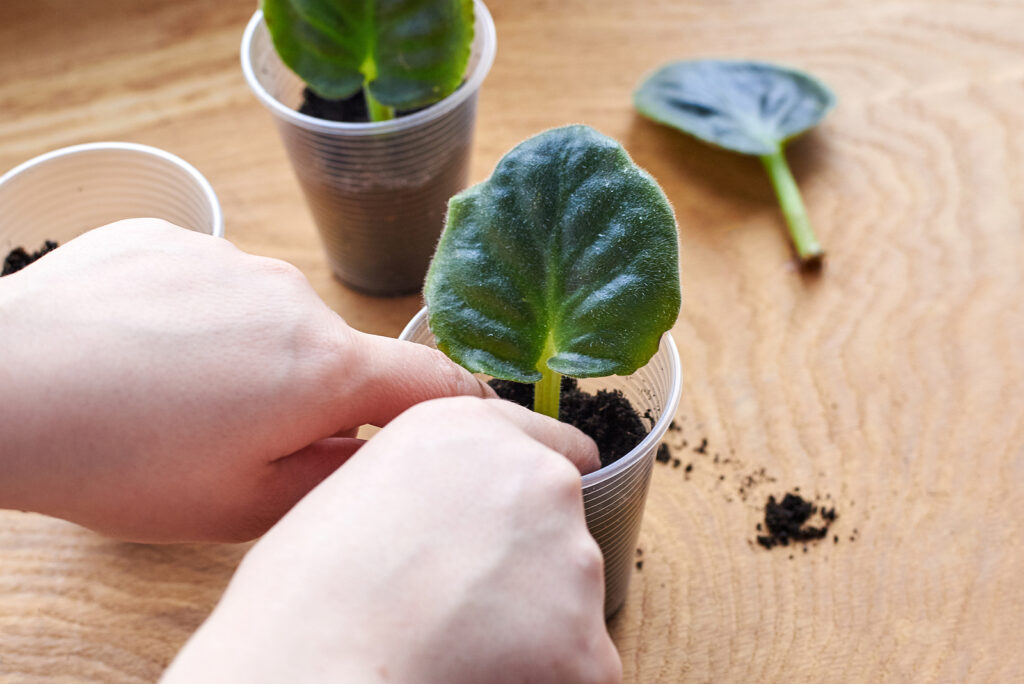The African violet features velvety-soft, round leaves, and flowers that range from the common purple to pink, white, and many colors in between, depending on the variety.
Often grown under artificial light, African violets require bright light, particularly during winter. It must also stay warm, 65° to 75°F (18°-24°C), and humid to prosper. Ideally, place the potted plant in a water-filled pebble tray to provide moisture in the air. Avoid splashing water onto the leaves; water can cause spotting.

Get to know African Violet – Saintpaulia
- Plant type: Tropical herbaceous perennial grown as a houseplant
- Growing Zones and range: Indoors
- Hardiness: Tender; keep warm 65° to 75°F (18°-24°C)
- Height and width: 2”-5” tall, 3”-10” wide depending on the type
- Foliage: Velvety, green, or variegated, fleshy leaves that grow between 3 and 12 inches (7.5-30cm) tall. Leaves are heart-shaped and hairy and grow in a basal rosette.
- Flowers: Single or double blooms to 2 inches (5cm) wide appear just above the leaves; flower colors in pink, reds, corals, purple, lavender, and white; flowers resemble violets; they are flat and five-lobed.
- Bloom time: Most types bloom several times a year
- Uses: Houseplant
- Common name: African Violet
- Botanical name: Saintpaulia spp.
- Family: Gesneriaceae
- Origin: Tropical East Africa

Where to plant African Violet – Saintpaulia
- Bright light, such as an east window in summer, and a south window in winter; to induce winter bloom, provide artificial light at night; does well long-term under grow lights
- Needs high humidity, set on a tray filled with pebbles and water.
- Plant in top-quality potting soil or a special mix for African violets
- Grow African violets in shallow pots.
Planting and spacing African Violet – Saintpaulia
- When planting, ensure the crown of the plant is above the level of the medium.
- Leaves that touch the rim of the pot are sometimes killed by contact with eh soluble salts that build up on the rim. To prevent this, line the rim with aluminum foil or wax.
How to water and feed African Violet – Saintpaulia
- Water by sitting the pot in a small bowl of water and letting the water soak upward
- Allow soil to dry slightly between waterings; water carefully to avoid wetting leaves. Cold water can cause spots on leaves.
- Fertilize with a half-strength 10-30-10 liquid fertilizer every time you water; fertilizers, especially for African violets, are ideal
African Violet – Saintpaulia care
- Avoid setting African violets in drafts.
- Add bonemeal each time you re-pot.
- A lack of flowers may mean that the plant isn’t getting enough light, that the temperature is too high, or the soil is too dry.
Growing Africa Violet – Saintpaulia as a houseplant
- African violets prefer a place where the temperature is warm light is bright and the humidity is medium to high.
- Plant in a rich, soilless, well-drained medium, and keep it evenly moist at all times.
- Be careful when watering not to drop water on the leaves or they will spot. Water only with warm water to prevent rings from developing on the leaves.
- When planting, ensure the crown of the plant is above the level medium.
- Plants can be grown under fluorescent lights especially in winter, to ensure maximum blooming.
- Fertilize twice a month when the plant is growing and flowering.
- Leaves that touch the rim of the pot are sometimes killed by contact with the soluble salts that build up on the rim. to prevent this, line the rim with aluminum foil or wax.

African Violet – Saintpaulia pests and diseases
- Insects that may attack African violets are aphids, mealybugs, thrips, root-knot nematodes, and spider and cyclamen mites.
- Diseases include botrytis blight, crown, and root rot.
- Keep the air circulating freely around the plants to reduce the chance of disease.
African Violet – Saintpaulia propagation
- Take leaf cuttings by removing a mature leaf with its 1.5-inch of the stem from the plant. Plant the leaf with its stem in a moist but loose potting medium.
- Mature leaves cut with plenty of petiole or leaf stem will root if placed in a glass of water with just enough water to cover the end of the stem but not up to the leaf. As soon as roots develop, move the plant to loose potting soil or sand.
- African violets can be divided when the crown gets overly thick and flowering wanes. Carefully pull apart the roots and crown and repot them; flowering usually begins soon afterward.
African Violet – Saintpaulia varieties to grow
- Hundreds of types are available. Choose from standard varieties that come in many sizes, from micro-miniatures that grow 2 inches to large types that grow up to 18 inches wide.
- Leaves can be plain or variegated or have interesting rolled, crinkled, or serrated edges.
- Flowers come in a variety of forms from single to semi-double, frilled, star, bicolors, and multicolors.
- Trailing types of African violets are available.
- Saintpaulia ionanthta. Grows 4 to 6 inches high; some varieties have green leaves; others have bronze or variegated leaves; hybrids that have white, pink, rose, blue, purple, or two-toned flowers 1 inch across and may be single or double; some varieties have ruffled petals, others frilled petals.
African Violet questions and answers
Q: My African violets quit flowering soon after I got them home from the nursery. Why?
A: Humidity is a big reason African violets quit blooming. Best flowering happens when the plants are kept standing on moist pebbles which give them a constant “aura of humidity. Faded flowers should also be snipped off right away; faded flowers that remain on the plant are a deterrent to further bud development. For plants that have been in the home for months and have quit blooming, repotting may be necessary. Do not feed African violets during the short periods when plants are resting and producing no new growth.
Q: My African violet has white rings and spots on the leaves. Is this a disease or a fertilizer problem?
A: Neither. White rings are the result of applying cold water to the soil or letting the water drop on the leaves. Warm water misted on the leaves is not harmful.
Q: How often should I feed my African violets?
A: You can feed them lightly at every watering except in periods when outside light is dull or when the plants are taking a brief rest after heavy bloom.
Q: What is the best location for African violets in summer?
A: Place them in a light north window in a well-ventilated room or else on a sheltered porch except when heat and humidity are high–then they are better indoors.
Q: How do I keep African violets free of dust?
A: Use a soft brush such as a flat camel’s hair paintbrush to remove dust. Leaves may be sprayed occasionally with a fine mist of room-temperature water. Until completely dry, the plants must be kept in shade and away from drafts.
Q: Why do African violets drop their flowers before they open?
A: Probably the temperature of the humidity is low. They want 70° to 72°F by day and not less than 60 at night. They prefer humidity around 60 percent.















